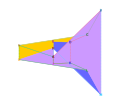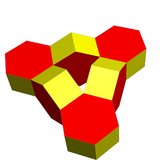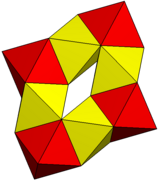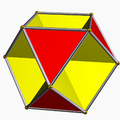Toroidal polyhedron

In
.Variations in definition
Toroidal polyhedra are defined as collections of
In this area, it is important to distinguish
In all of these cases the toroidal nature of a polyhedron can be verified by its orientability and by its Euler characteristic being non-positive. The Euler characteristic generalizes to V − E + F = 2 − 2g, where g is its topological genus.
Császár and Szilassi polyhedra
 |
 |
Two of the simplest possible embedded toroidal polyhedra are the Császár and Szilassi polyhedra.
The Császár polyhedron is a seven-vertex toroidal polyhedron with 21 edges and 14 triangular faces.[6] It and the tetrahedron are the only known polyhedra in which every possible line segment connecting two vertices forms an edge of the polyhedron.[7] Its dual, the Szilassi polyhedron, has seven hexagonal faces that are all adjacent to each other,[8] hence providing the existence half of the theorem that the maximum number of colors needed for a map on a (genus one) torus is seven.[9]
The Császár polyhedron has the fewest possible vertices of any embedded toroidal polyhedron, and the Szilassi polyhedron has the fewest possible faces of any embedded toroidal polyhedron.
Conway's toroidal deltahedron

A toroidal
Stewart toroids
A special category of toroidal polyhedra are constructed exclusively by
A restricted class of Stewart toroids, also defined by Stewart, are the quasi-convex toroidal polyhedra. These are Stewart toroids that include all of the edges of their convex hulls. For such a polyhedron, each face of the convex hull either lies on the surface of the toroid, or is a polygon all of whose edges lie on the surface of the toroid.[14]
| Genus | 1 | 1 |
|---|---|---|
| Image | 
|

|
| Polyhedra | 6 hexagonal prisms | 8 octahedra
|
| Vertices | 48 | 24 |
| Edges | 84 | 72 |
| Faces | 36 | 48 |
| Genus | 1 | 3 | 11 | 3 | 5 | 7 | 11 | |
|---|---|---|---|---|---|---|---|---|
| Image | 
|

|

|

|

|

|

|

|
| Polyhedra | 4 tetrahedra
|
6 triangular cupolae 6 square pyramids |
4 triangular cupolae 6 square pyramids |
24 tetrahedra
|
6 square cupolae 4 triangular cupolae 12 cubes |
8 triangular cupolae 12 cubes |
6 square cupolae 12 cubes |
6 square cupolae 8 triangular cupolae |
| Convex hull | truncated cube | truncated octahedron | truncated octahedron | expanded cuboctahedron | truncated cuboctahedron | truncated cuboctahedron | truncated cuboctahedron | truncated cuboctahedron |
| Vertices | 32 | 30 | 30 | 62 | 72 | 72 | 72 | 72 |
| Edges | 64 | 60 | 72 | 168 | 144 | 168 | 168 | 168 |
| Faces | 32 | 30 | 38 | 86 | 68 | 88 | 84 | 76 |
Self-crossing polyhedra
 Octahemioctahedron |
 Small cubicuboctahedron |
 Great dodecahedron |
A polyhedron that is formed by a system of crossing polygons corresponds to an abstract topological manifold formed by its polygons and their system of shared edges and vertices, and the genus of the polyhedron may be determined from this abstract manifold. Examples include the genus-1 octahemioctahedron, the genus-3 small cubicuboctahedron, and the genus-4 great dodecahedron.
Crown polyhedra
A crown polyhedron or stephanoid is a toroidal polyhedron which is also
See also
- Projective polyhedron
- Skew apeirohedron (infinite skew polyhedron)
- Spherical polyhedron
- Toroidal graph
References
- ^ Whiteley (1979); Stewart (1980), p. 15.
- S2CID 117884274.
- MR 0621628.
- ^ Ákos Császár, A Polyhedron Without Diagonals., Bolyai Institute, University of Szeged, 1949
- ISSN 1715-0868
- ^ Császár, A. (1949), "A polyhedron without diagonals", Acta Sci. Math. Szeged, 13: 140–142.
- S2CID 15911143.
- ^ Szilassi, Lajos (1986), "Regular toroids" (PDF), Structural Topology, 13: 69–80[permanent dead link].
- ^ Heawood, P. J. (1890), "Map colouring theorems", Quarterly Journal of Mathematics, First Series, 24: 322–339
- ^ Conway, John, "Polyhedra of positive genus", geometry.research Usenet group; see messages dated "Sep 23, 1997, 12:00:00 AM" announcing the toroidal deltahedron, and "Sep 25, 1997, 12:00:00 AM" describing its construction. Unlike the § Stewart toroids, it has coplanar adjacent triangles, but otherwise resembles a toroidal deltahedron with more faces described by Stewart (1980), p. 60.
- MR 2001419.
- ISBN 978-0-686-11936-4.
- ^ Stewart (1980), p. 15.
- ^ Stewart (1980), "Quasi-convexity and weak quasi-convexity", pp. 76–79.
- doi:10.1007/978-94-011-0924-6_3. See in particular p. 60.
